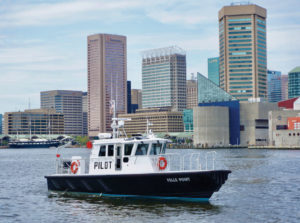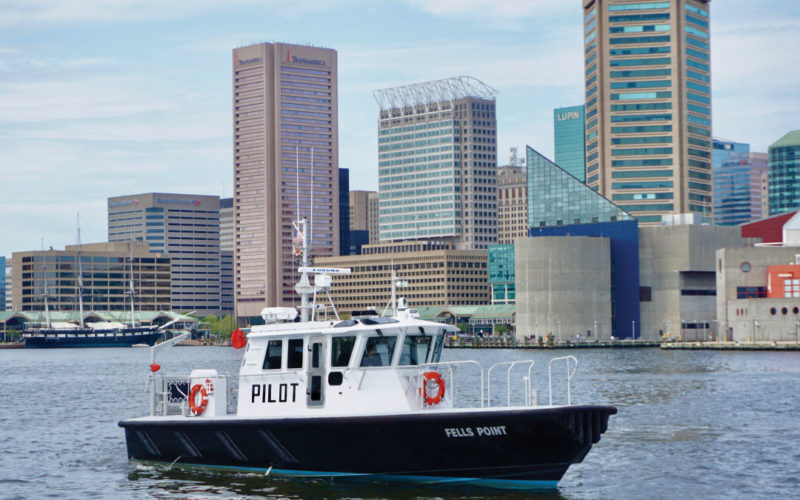
The Association of Maryland Pilots developed a new pilot boat class specifically for work around Baltimore Harbor.
The 48.5-foot aluminum Fells Point is the lead vessel in the pilots’ Baltimore class. Ray Hunt Design and Gladding-Hearn Shipbuilding collaborated on the vessel, which replaces the nearly 40-year-old Vedette.
Fells Point incorporates the best from the Maryland pilots’ larger Chesapeake-class launches. It is nimble, quick and stable alongside a ship. But unlike its larger siblings, the Baltimore class is designed for a single operator. The new design also offers better visibility, more safety features, a flat bow for dockside transfers and better electronics than the 42-foot Vedette.
“It is everything we wanted,” said Capt. Noah Seiple, marine superintendent for the Baltimore-based pilots group. “It has everything we asked Ray Hunt and Gladding-Hearn to incorporate when we started a new class.”
Fells Point is named for a historic Baltimore neighborhood settled in the late 1600s. Once a maritime and shipbuilding hub, the area is now anchored by townhomes and trendy restaurants. Future vessels in the series will be named for other sections of Baltimore.
The Maryland pilots’ 68 members guide ships the length of Chesapeake Bay, a transit that typically takes about 10 hours end to end. Fells Point operates in Baltimore, while four Halmatic monohulls typically operate in Annapolis and Solomons Island, near the Cove Point liquefied natural gas terminal. The group also operates four 53-foot Chesapeake-class launches at Cape Henry, Va., including Susquehanna, which was delivered in December.
The pilots began running the fiberglass Halmatics almost 40 years ago. They proved their worth over that time but in recent years began showing their age. The group considered multiple designs and shipyards before circling back to Gladding-Hearn and Ray Hunt Design.
“The reason we went with Gladding, in large part, was because so many pilots were so impressed with the first Chesapeake class,” said Capt. John Jamroga. “We trusted them.”
Winn Willard, president of Ray Hunt Design, said incorporating attributes from the larger boats into a smaller envelope was the primary challenge. In particular, the Maryland pilots wanted a vessel that retained the seakeeping capabilities and ergonomics of the Chesapeake class.
Ray Hunt naval architects developed a 48.5-by-15.5-foot vessel that draws about 4 feet. It has a flush deck and wheelhouse mounted amidships, offering a profile similar to the Chesapeake class. The deep-V hull form delivers comfort and efficiency while underway.
“Simply, (it is) not too heavy nor too light,” Willard said of the Baltimore class. “Strong, wide single chines in concert with properly placed spray rails give maximum static and dynamic stability. Experience with more than 75 pilot boat designs provides us a large database to design the next boat from.”
“The bow was chopped back above the chine and given heavy rubber protection for bow-on dock landings,” he continued. “Since the boat will not venture offshore, the small loss in reserve buoyancy was an acceptable tradeoff.”
Humphree interceptors installed at the transom contribute to the boat’s efficiency. The units hold the running trim at low angles at lower planing speeds, Willard explained, “allowing plenty of bow trim in following seas.”
Ensuring the new vessel could be operated safely by a single operator, without a deck hand, was another must-have. That meant designing the dash in a way that places navigation electronics within arm’s reach. It also spurred the development of a new man-overboard rescue device.
Fells Point is equipped with a custom-made J-basket on the transom that can scoop a person from the water and lift them to safety. The hydraulic system can be operated with a single hand from the aft helm station.
Seiple demonstrated the system on a recent afternoon in Baltimore Harbor with a mannequin wearing a personal flotation device. After tossing the mannequin overboard, he opened the aft control station and lowered the recovery device into the water. Steering with his right hand and controlling the J-basket with his left, he lined up and backed gently toward the mannequin. Once it was in position, he raised it out of the water. The entire rescue, from start to finish, took about two minutes.
A Harken safety harness system was incorporated into the vessel’s handrails to help prevent falls overboard. Fells Point also is equipped with a crank-operated rescue davit on the stern, similar to the Chesapeake-class vessels.
“There is a multitude of options to get that person back on the boat, but as you can see, I did it by myself,” Seiple said of the J-basket system, which was designed and built by Gladding-Hearn.
Other safety enhancements distinguish Fells Point from Vedette and its sister vessels. The new launch has heated decks and heated rails at the bow to melt ice during the winter months. Overhead windows allow the operator to see pilots as they embark or disembark, and side decks are twice as wide. The starboard-side door, along with the aft door, give the pilots two means of egress.
“There is so much more visibility,” said Joseph Cooke Sr., a boat operator who runs Vedette and Fells Point. “We can see the pilots as they come up or down the ladder because we have those windows overhead.”
The navigation electronics are another huge improvement. The operator is positioned in the center of the wheelhouse, between two Furuno touch-screen displays in the dash. The screens display radar and AIS, along with the feed from a FLIR thermal imaging camera. The Furuno loud hailer is pedal-activated, allowing the operator to keep their hands at the controls.
The dash layout is designed to keep important information at the operator’s fingertips, but not in their line of sight. Brian Kastner, the pilots’ Baltimore Harbor station manager, said the placement of the controls is particularly helpful after dark.
“The nighttime field of vision is phenomenal,” he said.
The propulsion package consists of twin 600-hp Volvo Penta D16 engines turning five-blade Bruntons propellers through ZF reduction gears. The maximum speed is 30 knots, while 25 is the boat’s most efficient cruise speed. Vedette, by comparison, cruises at about 17 knots. Electrical power comes from a single Northern Lights generator.
“The boat only has about 215 hours on it, so we are still getting fuel burn down, but for the same application, she is only burning 1.3 gallons more per hour for twice the horsepower,” Seiple said.
The pilothouse is equipped with five Norsap shock-mitigating seats, leaving space for four pilots. A portable toilet, tools and storage space are located below deck in the forecastle.
Fells Point’s flat bow is wrapped in Duramax 300 Series rubber, while the entire hull is wrapped in a 6-inch Duramax 500 Series shear guard. The port and starboard sides are protected by four diagonal rubber strakes to prevent metal-on-metal contact when coming alongside a ship.
Peter Duclos, president of Somerset, Mass.-based Gladding-Hearn, described Fells Point as a “big little boat” in its capabilities and outfitting. “It has basically everything a 50-footer would have in it,” he said. “It just happens to be smaller, narrower, lighter and faster.”
As of mid-August, the Maryland pilots were still acclimating to the new launch and its capabilities. Early indications suggest it checks all the right boxes.
“They did really well with this boat,” Seiple said. “We are very pleased with how she has been working out.”

